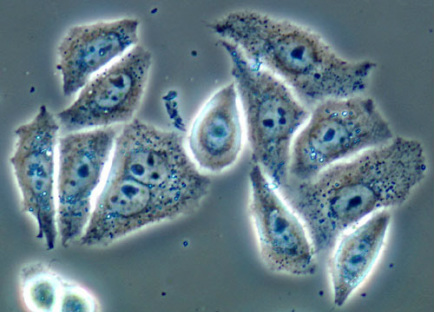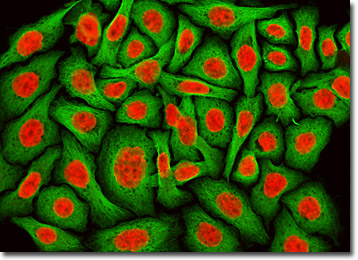They're called, HeLa. And they were first used in research that led to the Polio vaccine, as well as helping to develop medicines to fight cancer, the flu and Parkinson's disease, and in the research that led to gene mapping and cloning. They were used to test the effects of atomic radiation and sent into outer space.
All of the HeLa cells, trillions upon trillions of them, originally came from one person-Henrietta Lacks, a poor 30-year-old black woman who died nearly 60 years ago.
In 1951, Lacks went to Johns Hopkins Hospital in Baltimore suffering from cervical cancer. Before she died, doctors took some of her tumor cells for research without ever telling her.
Researchers discovered that those cells did something they'd never seen before: They could be kept alive and grow.
Lacks died later that year, but her cells lived on, providing a seemingly endless supply for researchers around the world, and eventually for companies to sell to sell for profit.
HeLa cells have since been used in many laboratories all over the world to make countless research discoveries. For example, shortly after Dr. Gey announced the HeLa cell line; it was used to propagate poliovirus, an event that played an important role in the development of poliovirus vaccines
Laboratories around the world use HeLa cells for propagating and studying many different viruses. Many of them have maintained the cells in suspension cultures since 1983. Over the course of 26 years, 600,000,000 HeLa cells have been produced in some laboratories each week, for a total of 800 billion cells. That is a lot of cells, but it’s nothing compared with the total number of cells – approximately 100 trillion – that make up a human.
While companies that sold HeLa cells made billions, Henrietta's family had little money, and, in perhaps the greatest irony, some of them could not afford health insurance.
To this day, Lacks' cells have led to major medical breakthroughs and the companies selling her cells make billions of dollars.
Nelson-Rees pointed out that while HeLa cell contamination is widespread, other human
and animal cells are contaminating one another “…techniques for maintaining cell purity must be applied to reduce it and the problems it presents to biologists through out the world.”
The HeLa cell-line can be classed as a “medical blessing” as they allowed for previously impossible medical research to be carried out. It can be argued, however, that HeLa cells turned out to be more of a medical curse. After the discovery of HeLa cells, as more and more laboratories began using human cells in culture, scientists were finding that since the introduction of HeLa cells, these other cell cultures also began to multiple indefinitely. For two decades research was done on what were thought to be normal human cells, for example placental cells, but in 1974 it was revealed that HeLa cells - due to their robust nature and ability to spread and multiply so considerably - had contaminated the world’s stock of cell cultures. This meant that billions had been spent on isolated tissue cultures, that turned out to be invalid as they were revealed to be HeLa cells. Although this caused obvious setbacks in the scientific world, I think that some good may have come out of it, as the methods of preparation and study of cell cultures has been vastly improved since then, meaning the potential for human error has been significantly reduced.
Hopefully I have explained sufficiently the ethical and medical dilemmas surrounding the immortal HeLa cells, but what of the other question of the evolution of a post-human species? This question arises when we look at some of the unique features of HeLa cells; mainly that they are unarguably human - haven been extracted directly from a human source - but equally they have 82, instead of 46, Chromosomes in their nuclei (four copies of chromosome 12 and three copies of chromosomes 6, 8 and 17). In theory, if a HeLa cell could produce a gamete, it would not be able to fertilize with a human gamete (due to the different number of chromosomes) - which, by laws of classification, means that HeLa cells are an entirely new species - Helacyton gartleri - to use it’s proper given name.
It would appear that through the mechanism of random mutations, the cervical cancer cells in Henrietta Lacks body found a selective advantage, that allowed them to proliferate indefinitely and to live for an extended length of time. But what is this selective advantage that has allowed HeLa cells to flourish? Research has shown that HeLa cells have an active form of the enzyme Telomerase (not present in normal cells, but can be found in most cancerous cells). Telomerase is active during cell division, and prevents the shortening of telomeres - a mechanism that is associated with ageing and eventual cell death.
It may be argued then, that cancer cells are a mode of “microevolution“; the cells within us are subject to the same laws of natural selection as we are, with HeLa cells emerging as the next branch of the evolutionary tree.
To conclude, I think that HeLa cells are all of an ethical nightmare, medical blessing, and evolution of a post-human species. The Lacks family never gave their consent for Henrietta’s cells to be used in research, neither did they receive any acknowledgment for the great medical advances Henrietta gave to the world. However, since the cells are technically not human, does the family have any right to them? Certainly this can be classified as an ethical nightmare.
From looking at the medical advances HeLa cells have provided, I would agree that they are a medical blessing, especially in light of their ability to keep their telomeres intact, which is now being used in medical research to see if the same mechansim can elongate human life.
The image below shows all the recent discoveries in medical history due to HeLa cells.
WORK CITED
1) http://www.wired.com/magazine/2010/01/st_henrietta/
2) http://abcnews.go.com/WN/henrietta-lacks-woman-cells-polio-cancer-flu-research-medicine/story?id=9712579
3) http://www.smithsonianmag.com/science-nature/Henrietta-Lacks-Immortal-Cells.html
4) http://www.libguides.library.ncat.edu/content.php?pid=132289&sid=1180198
1) http://www.wired.com/magazine/2010/01/st_henrietta/
2) http://abcnews.go.com/WN/henrietta-lacks-woman-cells-polio-cancer-flu-research-medicine/story?id=9712579
3) http://www.smithsonianmag.com/science-nature/Henrietta-Lacks-Immortal-Cells.html
4) http://www.libguides.library.ncat.edu/content.php?pid=132289&sid=1180198




